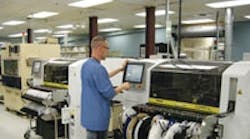John Biuso occasionally shows employees video clips of a Kodak manufacturing plant in Rochester, N.Y., being demolished. As a former Kodak employee, Biuso points out that he knows firsthand what can happen to a plant if it doesn’t evolve.
Today, Biuso is the process improvement manager at the IEC Electronics Corp. circuit-board assembly plant in Newark, N.Y. Like the nearby Kodak plant in Biuso’s video, IEC’s Newark operation was once in danger of imploding, too. The Rochester-area plant struggled to remain viable as low-cost countries took over production of the motherboards IEC once produced for personal computers.
In 2005 the facility found itself in the unenviable position of either starting over or shutting down. The company chose the former with the goal of diversifying its product portfolio and establishing lean manufacturing and Six Sigma processes.
The contract manufacturer moved to a high-mix, low-volume model of primarily build-to-order printed circuit boards for growing industries, including medical device and aerospace and defense manufacturing. “It was do-or-die at this plant if we didn’t diversify,” Biuso recalls. Over the five-year transition period, IEC’s companywide sales, led by the Newark plant, increased 500%.
The plant’s resurgence can be attributed to capital upgrades that reduced machine changeover times, a move from batch manufacturing to one-piece flow, and a renewed focus on product development and in-house capabilities not easily replicated by competitors.
IEC invested $2 million in new automated assembly equipment that cut setup time in half over a three-year period. A row of feeders similar to film reels deliver tiny circuit board components seated in carrier tape into the robotic machine that assembles the boards. Previously, line workers changed feeders individually to replenish parts, a process that took approximately one hour, Biuso says. The new equipment allows the plant to swap out entire feeder racks that are kept at lineside. The changeover process now takes approximately five minutes.
Lines are located in different “focus factories” dedicated to specific market segments. One area that’s helped the plant secure new orders is its prototyping line. IEC separated the prototyping line from other focus factories to prevent production slowdowns in those areas, says Mark Talmadge, director of new product introduction. A “new product introduction ambassador” will hand-deliver the prototype and answer any questions the customer might have, he says. This helps build relationships with IEC customers.
Another capability that plant managers tout as a competitive advantage is the facility’s materials analysis lab. The plant employs two people with PhDs who conduct destructive analysis on defects that aren’t easily identified rather than sending the product to an outside lab. The process provides the plant with more intimate knowledge of customer problems and allows for a quicker response time, Biuso says.
By incorporating such innovative capabilities into its operations, the IEC plant has positioned itself for future growth and given hope to a regional workforce that’s all too familiar with the perils of stagnation.
Jonathan Katz is managing editor of MH&L’s sister publication, IndustryWeek. Learn more about the IndustryWeek Best Plants program at www.iwbestplants.com.




